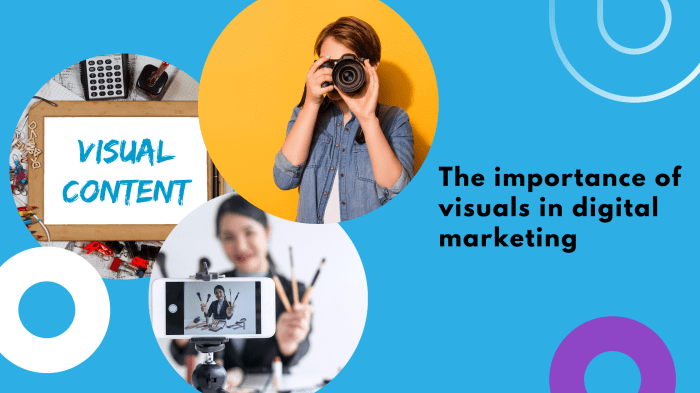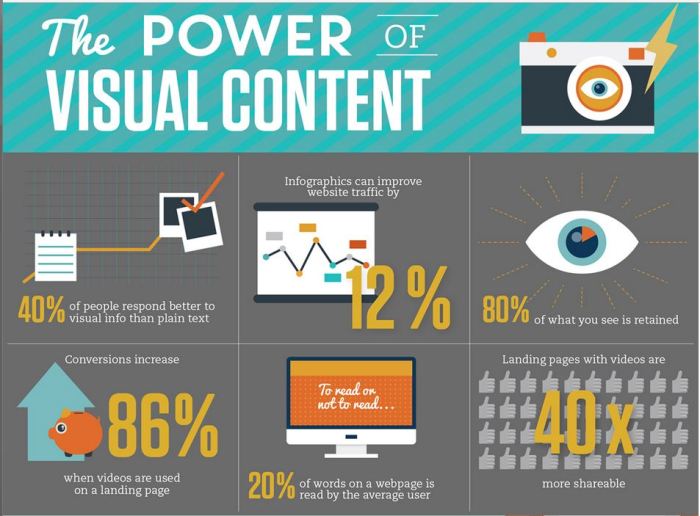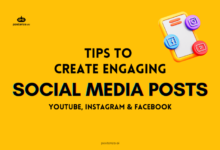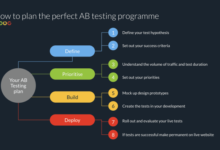
The impact of visual content in digital marketing is undeniable, as it plays a crucial role in captivating audiences and conveying brand messages effectively. From images to videos and infographics, visual content has the power to shape consumer behavior and drive successful marketing campaigns.
In this article, we will delve into the significance of visual content, explore different types of visuals, dive into creation processes, analyze consumer behavior influences, discuss optimization strategies, and provide valuable tips for maximizing the impact of visual content in the digital marketing landscape.
Importance of Visual Content
Visual content plays a crucial role in digital marketing as it helps to grab the attention of the audience, convey messages effectively, and enhance brand visibility. In today’s fast-paced digital world, where individuals are constantly bombarded with information, visual content stands out and captures the audience’s interest much quicker than text alone.
Examples of Effective Visual Content
- Infographics: Infographics are a popular and effective way to present complex information in a visually appealing format. They are widely shared on social media platforms and websites.
- Video Marketing: Videos have become a powerful tool in digital marketing, with platforms like YouTube, TikTok, and Instagram Reels gaining immense popularity. They allow brands to tell stories, showcase products, and engage with their audience in a more dynamic way.
- Social Media Images: Platforms like Instagram and Pinterest rely heavily on visual content. High-quality images and graphics on these platforms can significantly impact brand visibility and engagement.
How Visual Content Enhances Brand Awareness
Visual content can enhance brand awareness by creating a strong visual identity that resonates with the target audience. When consumers see consistent and visually appealing content from a brand, they are more likely to remember it and associate positive emotions with it. This, in turn, leads to increased brand recognition and loyalty.
Types of Visual Content
Visual content plays a crucial role in digital marketing, capturing the attention of audiences and conveying messages effectively. Different types of visual content are utilized to engage viewers and enhance brand visibility.
Images
Images are one of the most commonly used types of visual content in digital marketing. They can include photographs, illustrations, graphics, and memes. Images are powerful in evoking emotions, creating a visual identity for brands, and enhancing the overall aesthetic appeal of content.
Videos
Videos have become increasingly popular in digital marketing due to their engaging nature. They can include promotional videos, tutorials, product demonstrations, and live streams. Videos have the ability to convey complex information in a digestible format, increasing audience retention and interaction.
Infographics
Infographics are visual representations of data, information, or knowledge. They combine text, images, and design elements to present content in a visually appealing and easy-to-understand manner. Infographics are effective in simplifying complex concepts, making statistics more engaging, and increasing shareability on social media platforms.
Animations
Animations are dynamic visual content that can include cartoons, motion graphics, and interactive elements. They are engaging and entertaining, capturing the audience’s attention and conveying messages in a memorable way. Animations are particularly effective in storytelling and explaining abstract concepts.
Interactive Content
Interactive content allows users to engage with visual elements actively. This can include quizzes, polls, calculators, and interactive maps. Interactive content enhances user experience, encourages participation, and provides valuable insights into audience preferences and behaviors.
Comparing Effectiveness
Each type of visual content has its unique characteristics and advantages in engaging audiences. Images are quick to consume and can evoke emotions effectively. Videos have high engagement rates and are ideal for storytelling. Infographics are excellent for presenting data and statistics in a visually appealing way. Animations and interactive content are highly engaging and interactive, increasing user participation and retention.
Visual Content Creation

Creating engaging visual content for digital marketing requires a strategic approach to capture the attention of the target audience and convey the intended message effectively. It involves a combination of creativity, design skills, and an understanding of the brand identity and audience preferences.
Tips for Designing Visual Content
- Know your audience: Conduct research to understand the demographics, interests, and preferences of your target audience to tailor your visual content accordingly.
- Create a style guide: Establish brand guidelines for colors, fonts, imagery, and overall aesthetics to maintain consistency in visual branding across different platforms.
- Tell a story: Use visuals to tell a compelling story that resonates with your audience and evokes emotions to create a connection.
- Keep it simple: Avoid cluttered designs and focus on clear, concise visuals that communicate the message effectively.
- Optimize for different platforms: Adapt your visual content for various platforms, considering the size, format, and viewing behavior of users on each platform.
Maintaining Consistency in Visual Branding
Consistency in visual branding is essential to build brand recognition and trust among the audience. Here are some practices to ensure consistency across different platforms:
- Use the same color palette, fonts, and design elements in all visual content to create a cohesive brand identity.
- Create templates for social media posts, ads, and other visual assets to maintain a consistent look and feel.
- Implement a content calendar to plan and schedule visual content in advance, ensuring a consistent posting frequency.
- Monitor and analyze the performance of visual content to identify what resonates with the audience and refine your visual branding strategy accordingly.
Impact on Consumer Behavior: The Impact Of Visual Content In Digital Marketing
Visual content plays a crucial role in influencing consumer behavior, especially in the digital marketing landscape. The use of compelling visuals can significantly impact consumer decision-making, perception, and purchasing behavior.
Psychological Impact of Visuals on Consumer Perception, The impact of visual content in digital marketing
Visual content has a powerful psychological impact on consumer perception. Images and videos can evoke emotions, create connections, and leave a lasting impression on consumers. For example, seeing vibrant images of happy people using a product can influence a consumer’s perception of that brand as positive and trustworthy.
Influencing Purchasing Behavior
Visual content can also directly impact purchasing behavior. High-quality images and videos showcasing products or services can entice consumers to make a purchase. For instance, visually appealing product photos highlighting key features can drive conversions and increase sales.
Examples of Successful Digital Marketing Campaigns
Several successful digital marketing campaigns have been driven by compelling visual content. One notable example is the “Share a Coke” campaign by Coca-Cola, where personalized labels with people’s names and messages were featured on the iconic soda cans. This campaign not only increased brand engagement but also boosted sales significantly.
Another example is the “Dumb Ways to Die” safety campaign by Metro Trains in Melbourne, Australia. This campaign used a catchy song and cute animated characters to deliver a serious safety message. The visuals went viral, reaching millions of people worldwide and effectively raising awareness about railway safety.
Visual content is a powerful tool in digital marketing, with the ability to shape consumer behavior, perception, and ultimately drive successful campaigns.
Visual Content Optimization

Visual content optimization is crucial for ensuring that images and videos are easily discoverable by search engines, leading to increased visibility and engagement. By implementing strategies to enhance the accessibility of visual content, businesses can reach a wider audience, including users with disabilities.
Importance of Optimizing Visual Content for Search Engines
Optimizing visual content for search engines involves adding relevant s, meta tags, and descriptions to images and videos. This helps search engine crawlers understand the content and context of the visuals, improving the chances of being displayed in search results.
- Use descriptive filenames for images and videos that include relevant s.
- Include alt text for images to provide text-based descriptions for screen readers used by visually impaired users.
- Create sitemaps specifically for visual content to help search engines index and rank images and videos.
Strategies for Improving Visibility of Visual Content in Search Results
Enhancing the visibility of visual content in search results requires a combination of technical optimization and content quality. By following these strategies, businesses can improve their chances of ranking higher in search engine results pages.
- Optimize image and video file sizes to improve loading speed and user experience.
- Create high-quality visuals that are relevant to the content on the page.
- Implement structured data markup to provide search engines with additional context about the visual content.
Techniques for Enhancing Accessibility of Visual Content for Users with Disabilities
Ensuring that visual content is accessible to users with disabilities is essential for providing an inclusive online experience. By following these techniques, businesses can make their visual content more user-friendly and compliant with accessibility standards.
- Provide text alternatives for images and videos, such as alt text and captions.
- Use high color contrast and clear visuals to aid users with visual impairments.
- Include audio descriptions for videos to describe visual elements for users who are blind or have low vision.
Conclusive Thoughts
As we conclude our exploration of the impact of visual content in digital marketing, it becomes evident that embracing visual storytelling is essential for brands looking to stand out in a crowded digital space. By leveraging the power of visuals effectively, businesses can create lasting impressions, foster brand loyalty, and drive meaningful engagement with their target audience.
When it comes to content marketing on a budget, there are several strategies that businesses can implement. One effective approach is to focus on creating high-quality, engaging content that resonates with the target audience. Additionally, utilizing social media platforms and email marketing can help maximize reach without breaking the bank.
For more tips on how to effectively market your content on a budget, check out this article on Strategies for content marketing on a budget.
Protecting digital assets is crucial in today’s cyber landscape. Implementing cybersecurity measures such as encryption, multi-factor authentication, and regular security audits can help safeguard sensitive information from potential threats. To learn more about the best practices for securing your digital assets, be sure to read this informative article on Cybersecurity measures to protect digital assets.
Understanding what a server rack is essential for managing IT infrastructure efficiently. A server rack is a framework designed to house multiple servers, providing organization and easy access for maintenance. To delve deeper into the functions and benefits of server racks, you can refer to this comprehensive guide on What is a server rack.









